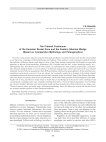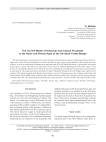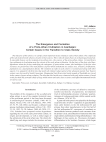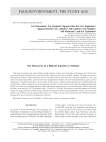Archaeology, Ethnology & Anthropology of Eurasia @journal-aeae-en
Статьи журнала - Archaeology, Ethnology & Anthropology of Eurasia
Все статьи: 524

Статья научная
This article discusses difficulties in the use of Japanese archaeological terminology, especially with regard to the Jōmon period. The history of the notions of “style”, “type”, and “form” is outlined, which are the most adequate concepts for the interpretation, classification, and description of new styles of the Jōmon pottery. The evolution of the terms is traced using the works by Yamanouchi Sugao and Kobayashi Tatsuo. Their basic views on the typology of Jōmon artifacts and the notions behind the key terms are described.
Бесплатно

The Tamga signs of the Turkic nomads in the Altai and Semirechye: comparisons and identifications
Статья обзорная
Бесплатно

The Umrevinsky hoard of silver wire kopecks from the reign of Peter I
Статья научная
The Umrevinsky hoard, comprising 107 silver wire kopecks, was found in 2008 outside the walls of Fort (Ostrog) Umrevinsky, founded in 1703 on the right bank of the Ob River, 100 km north of Novosibirsk. This is the fi rst time such a hoard has been discovered in the Novosibirsk stretch of the Ob. Its composition is assessed with reference to archaeological fi ndings relating to Fort Umrevinsky. The chronology of the coins and of their deposition is evaluated. The location is near a dwelling within a manor, in an ash-layer. The coins are relatively poorly preserved. We were able to identify the minting-years of 34 coins. All specimens with legible stamp-impressions were minted between 1696 and 1717. On the basis of the results, it is concluded that this was a hoard of coin-silver. Firstly, most kopecks bear no discernible images that would guarantee specifi c weight and silver content; secondly, the hoard was deposited no earlier than 1735, i.e., 20 years after the coins had gone out of use. This conclusion is supported by the fact that some coins were apparently used as ornaments that were sewn on clothes by the natives. All these fi ndings enrich our knowledge of the history of Fort Umrevinsky.
Бесплатно

The Vengerovo-2A Neolithic cemetery, Southwestern Siberia: results of a multidisciplinary study
Статья
Бесплатно

The Wanyan Digunai (Wanyan Zhong, Esikui) funerary complex in Primorye
Статья научная
The article outlines the findings of studies of a funerary complex beside the stone sculpture of a bixi turtle, discovered in 1893 on the territory of the mill of O.V. Lindholm in Primorye. The present research is based on unpublished diaries (from 1893 and 1894) of F.F. Busse, who carried out rescue excavations of the hill under the sculpture and unearthed a stone coffin buried nearby. A rounded stele top with 20 Chinese characters was found at the same place. The translation demonstrates that the burial was that of a prominent Jurchen military leader belonging to a noble Wanyan clan— Wanyan Digunai (Chinese name Wanyan Zhong, 完颜忠 , known as Esikui/Asukui, 阿思魁 ). The burial was largely neglected, because scholars focused on translating and interpreting the inscription. The burial was believed to have been looted long ago, and Busse's diaries remained unpublished. The focus of the present study, therefore, is to describe all available sources relating to Wanyan Digunai's funerary complex. Based on the analysis of the excavation findings, features of the funerary rite are reconstructed. The architectural design and layout of the complex are shown to have followed the local East Asian tradition.
Бесплатно

The beginning of iron metallurgy in East Asia
Статья научная
This study focuses on the beginning of the Early Iron Age in the Far East. A revision of the published data indicates a lack of synchrony in the appearance of bronze artifacts in cultures of the Amur region and Primorye in the late 2nd to early 1st millennia BC. Iron and cast iron were widely distributed in the Urilsky and Yankovsky cultures. However, no such artifacts are known in contemporaneous cultures such as the Evoron, Siniy Gai, and Lidovka, which are attributed to the Bronze Age, whereas the earliest iron and cast iron artifacts of the Urilsky culture come from the western parts of the Amur basin. All known bronze artifacts of that culture were widely distributed during the Shang and Western Zhou stages, in Karasuk-type cultures of Southern Siberia and Central Asia of the late 2nd to early 1st millennia BC. In China, the earliest iron artifacts appeared between the 8th and 6th centuries BC, while in the provinces of eastern Liaoning and southwestern Jilin they appeared between the 4th and 1st centuries BC. Cast iron celts of the Yankovsky culture in Primorye, which in 1960s were dated to 1000–800 BC, are now believed to be no earlier than 400–200 BC, coinciding with the appearance of iron in Manchuria. It is concluded that in East Asia, iron and cast iron first appeared in the western Amur basin in 1100–900 BC.
Бесплатно

The concept of civilization in modern studies of the Neolithic in China and Japan
Статья научная
This paper presents a brief overview of studies exploring the origin of civilizations in modern archaeology of China and Japan and mostly concerning the Neolithic period. The analysis of publications shows that in Chinese and Japanese archaeology, original scholarly traditions have been developed, with their own methodological foundations and terminology. We outline the key ideas relating to the origin of civilization, elaborated by researches in China (Su Bingqi, Yan Wenming, Li Boqian, Xu Hong, Gao Jiangtao) and Japan (Harunari Hideji, Watanabe Hiroshi, Sasaki Fujio, Yasuda Yoshinori). We show that most Chinese scholars consider the formation of state a sine qua non of transition to the civilization stage. However, the problem of identifying criteria of civilization and state formation using archaeological data has not been resolved to date. Examples of archaeological markers of civilization proposed by Chinese specialists are listed. In the works by Japanese researchers, no connection between the emergence of the state and civilization has been revealed. Most Chinese archaeologists date the emergence of civilization and of the fi rst state formations to the Late Neolithic (Dawenkou, Hongshan, Liangzhu, Longshan, etc.), ca 3500–2000 BC. There are alternative hypotheses—the Early Bronze Age (Erlitou culture) and the Late Bronze Age (the Spring and Autumn period). In Japanese archaeology, there are two main positions regarding the time when civilization had formed—the Jōmon period (Neolithic) and the subsequent Yayoi period (Bronze Age). Scholarly and external (including political) factors that have infl uenced modern concepts of the origin of civilization require special historiographic research.
Бесплатно

The consecration of altars in 17th–21st century Siberian orthodox churches: the neurosymbolic aspect
Статья обзорная
Бесплатно

Статья научная
Over the recent decade, abstracts of many thousands of folktales recorded in Europe and Asia have been added to our Electronic Catalogue of World Mythology and Folklore. Their analysis reveals systematic parallels between the traditions of Western Eurasia and America, those of the Plains Indians in particular. Such motifs are especially apparent in Ancient Greek mythology (Phaethon’s fall, Pasiphae and the bull, cranes attacking dwarfs, etc.). Although they have been known since the 19th century, no explanation for them could be proposed for a long time. The situation changed thanks to recent advances in Siberian paleogenetics. Before the peak of the Last Glacial Maximum, Eastern Siberian populations (Yana RHS and Malta) exhibited European affinities. By the mid-Holocene, population replacement occurred. It was not abrupt, but eventually resulted in a breakup of the initial cultural continuum spanning the Eurasian boreal zone and later extending to the New World. Many of the Western Eurasian–American motifs are episodes from stories of adventures. On the other hand, parallels between traditions of the Indo-Pacific rim of Asia and America mostly relate to motifs that are mythological in the narrow sense (etiological and cosmological), including early ones, evidently stemming from Africa. From the Hunno-Sarmatian, if not Scythian age onward, Southern Siberian and Central Asian motifs had been transferred to Western Eurasia on a large scale. Classical sources mirror an earlier stage of European mythology, hence the difference between the Ancient Greek set of motifs and that peculiar to later European traditions.
Бесплатно

Статья научная
This article presents a current perspective on the historical and cultural development of the population in the foreststeppe zone of the Ob-Irtysh interfl uve in the Stone and Bronze Ages, using various methods of the natural and exact sciences, as well as archaeological fi ndings from adjacent parts of the Ob and Irtysh basins. A geographic description of the region is given. The history of excavations in the region is outlined beginning from the 19th century to the present. A considerable amount of new materials has been accumulated, providing the basis for historical and cultural reconstructions. The study spans the period from the Upper Paleolithic through to the Late Middle Ages and the recent centuries. The initial peopling of the Baraba forest-steppe occurred 18 thousand years ago. Cultures of the Early and Late Neolithic, Early, Middle and Late Bronze Ages, and the transition to the Early Iron Age are listed. All periods have a reliable timescale. The archaeological potential of the region provides a basis for further elaborations of this model.
Бесплатно

The earliest Paleolithic assemblages from Denisova cave in the Altai
Статья научная
The article presents the results of multidisciplinary studies of the Early Middle Paleolithic assemblages from the lower part of the Denisova Cave Pleistocene sequence in the East Chamber and the Main Chamber of the cave. Data on geochronology, small and large vertebrate fauna, palynology, stratigraphy and micromorphology of sediments containing the earliest archaeological fi nds at the site, as well as on petrography, traceology and archaeozoology are presented. We des cribe human fossils and aDNA studies based on them. These materials demonstrate that the fi rst inhabitants of the cave and those associated with the Early Middle Paleolithic traditions were Denisovans. On the basis of the collection, which includes over 35,000 artifacts, the technology and typology of the Denisova industry are reconstructed. We focus on the comparison of the Denisova Early Middle Paleolithic with chronologically closest industries of North and Central Asia. The most similar industry is the Acheulo-Yabrudian of the Near East. Parallels concern primary reduction techniques and tool types. A hypothesis explaining the appearance of Middle Paleolithic traditions in Southern Siberia is proposed. We demonstrate continuity in the evolution of the lithic industries of Denisova up to the autochthonous emergence of the Upper Paleolithic ca 50,000 years ago.
Бесплатно

The early Neolithic complex on the Tartas-1 site: results of the AMS radiocarbon dating
Статья
Бесплатно

Статья научная
The objective of this article is to clarify certain important issues relating to early urban culture. The complexity of the task stems from the absence of early written sources. This is why the study draws on archaeological materials. It especially focuses on the incipient proto-urban sites—the sources of the proto-urban culture. Certain Bronze Age settlements in Azerbaijan meet the criteria of the early urban civilization. On the basis of the facts cited here, hypotheses about the factors underlying the emergence of proto-urban centers (the harbingers of the first class societies) are put forward. The main features of proto-urban settlements are surface area, structure, fortifications, population size, and population density. The evolution of crafts in such centers is reconstructed along with other aspects. It is argued for the first time that nearly all cultural values typical of the advanced ancient Near Eastern centers were borrowed by South Caucasians. Monumental Late Bronze Age burial mounds of Karabakh are viewed in the context of proto-urban evolution. The idea that elite burials were connected with early urban centers is based on the fact that only powerful chiefs of large tribal unions and early class societies could afford monumental burials on such a scale.
Бесплатно








